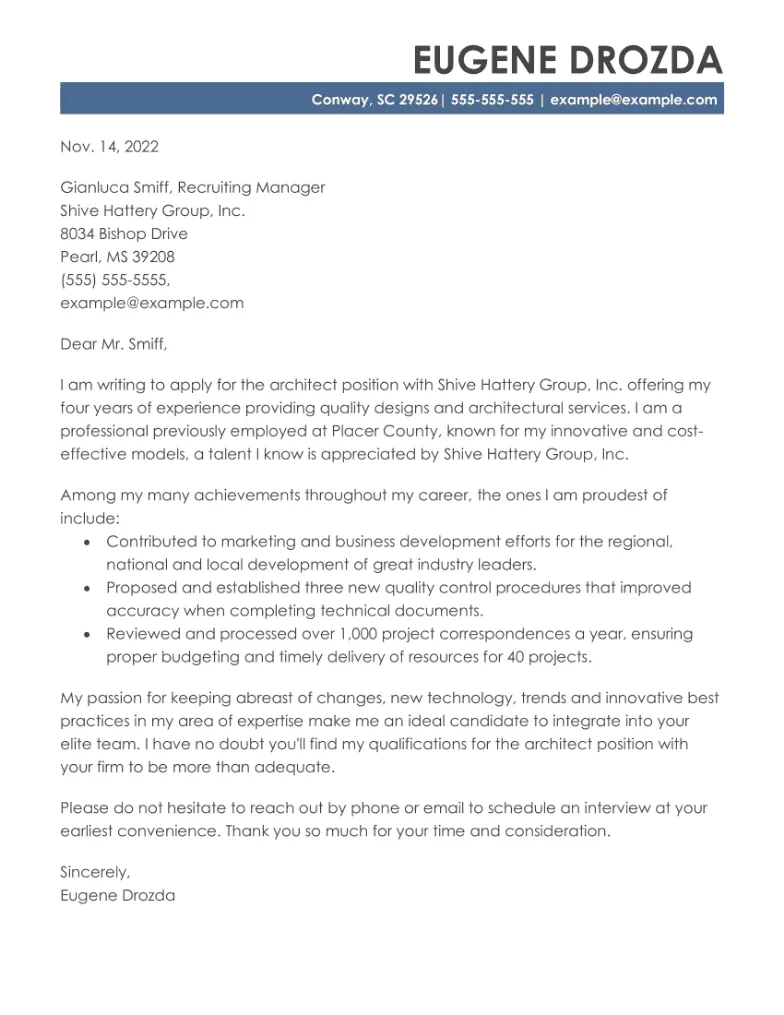Crafting a Compelling Architect Cover Letter
A well-crafted architect cover letter is more than just a formality it’s your opportunity to make a strong first impression and secure an interview. It allows you to showcase your unique skills, experience, and passion for architecture in a way that your resume alone cannot. This guide provides proven tips to help you create a cover letter that captivates hiring managers and highlights your potential as a valuable asset to their firm. By following these guidelines, you will learn how to present your qualifications in the most effective manner possible, increasing your chances of landing your dream architecture job. Remember, your cover letter is your chance to shine and demonstrate why you are the ideal candidate.
Understanding the Purpose of an Architect Cover Letter
The primary purpose of an architect cover letter is to introduce yourself to the hiring manager, express your interest in the specific position and company, and highlight the key aspects of your qualifications that make you a suitable candidate. It’s not merely a summary of your resume; instead, it’s a narrative that demonstrates your enthusiasm and connects your skills and experience with the needs of the firm. It should clearly state why you’re interested in the role and what you can bring to the team. It should be persuasive and give the reader a reason to delve deeper into your resume and ultimately invite you for an interview.
Highlighting Your Architectural Skills and Experience
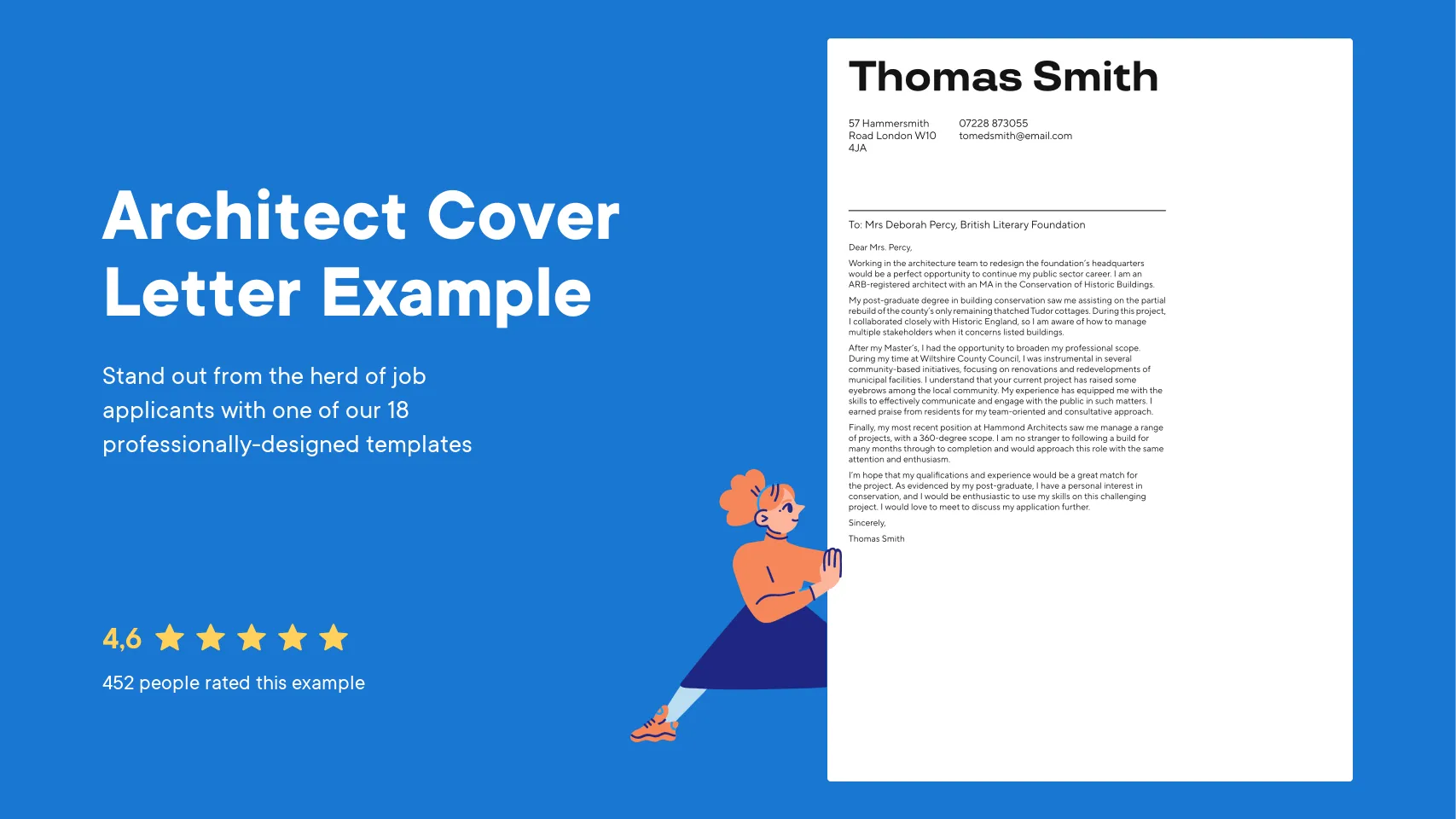
Your cover letter should prominently feature your architectural skills and experience. This is where you can make a strong case for your abilities, showing the hiring manager that you possess the required competencies. Don’t just list your skills; provide concrete examples of how you’ve utilized them in previous projects. Quantify your achievements whenever possible, using metrics to demonstrate the impact you’ve made. For instance, highlight how you’ve improved design efficiency, contributed to project success, or enhanced client satisfaction. This approach allows you to showcase your accomplishments and illustrate your ability to deliver results.
Key Skills to Showcase in Your Cover Letter
When writing your cover letter, highlight a range of skills that are essential for the role. Some of these might include design software proficiency (AutoCAD, Revit, SketchUp), project management, construction documentation, and knowledge of building codes and regulations. Strong communication and teamwork abilities are also critical. Mention your ability to collaborate with clients, contractors, and other professionals. Leadership skills, like the ability to manage a team, could also be a significant advantage. Tailor the skills you list to match the requirements outlined in the job description.
Relevant Experience to Feature
Your cover letter should showcase your relevant experience, focusing on the projects and roles that align with the job you’re applying for. Describe your responsibilities and accomplishments in each role, highlighting projects where you’ve played a significant role. Include the types of buildings you have experience designing, the scale of projects you have managed, and any specializations you possess. Showcase projects that demonstrate your abilities, such as sustainable design expertise or experience with specific building types. Provide specific examples of how you contributed to successful project outcomes, emphasizing any awards, positive reviews, or client satisfaction you achieved.
Formatting Your Architect Cover Letter
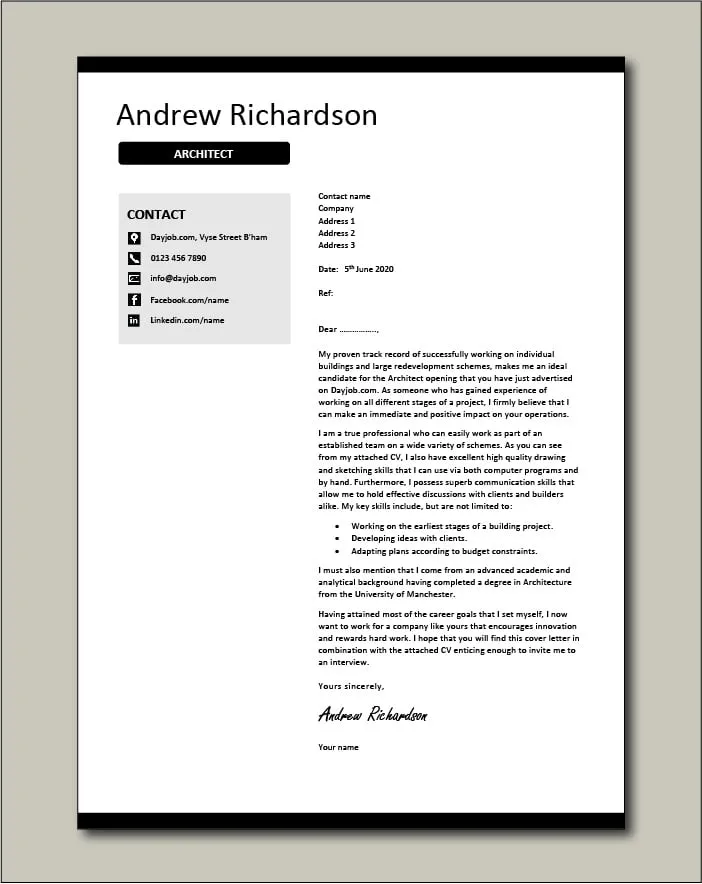
The format of your architect cover letter plays a vital role in presenting a professional and polished image. A well-formatted cover letter demonstrates attention to detail and professionalism, which are crucial attributes in architecture. Ensure that your formatting is clean, easy to read, and visually appealing. The layout should reflect the standards of professional communication and make it simple for the hiring manager to quickly grasp the essential information. Use a standard, readable font such as Times New Roman or Arial, and use a font size between 10 and 12 points. Use single-spacing within paragraphs and double-spacing between paragraphs. Keep the margins at 1 inch on all sides and align the text to the left. Break up large blocks of text with shorter paragraphs to maintain readability.
Contact Information and Header
Your contact information should be located at the top of the letter, typically on the left-hand side. Include your full name, address, phone number, and professional email address. Ensure your email address is professional and easy to read. Your contact information should match what is listed on your resume. In the header section, you can also include the date, the name of the hiring manager (if known), the hiring manager’s title, and the company’s address. Always double-check the address and name for accuracy.
Salutation and Addressing the Hiring Manager
The salutation should be polite and professional. If you know the hiring manager’s name, use it (e.g., “Dear Mr./Ms. [Last Name]”). If you don’t know the hiring manager’s name, use a general salutation such as “Dear Hiring Manager” or “Dear [Company Name] Team”. Avoid informal greetings like “Hi” or “Hello”. Make sure you spell the name of the hiring manager correctly. Doing so shows respect for the individual and the company. Make sure the salutation aligns with the tone of the rest of your letter.
Body Paragraphs The Core of Your Letter
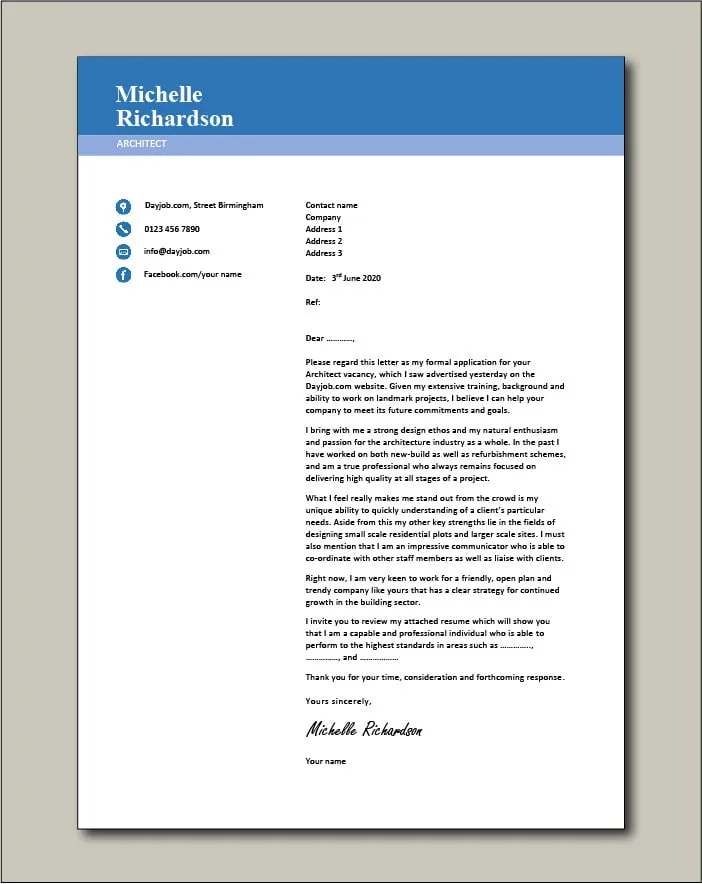
The body paragraphs of your cover letter are the heart of your communication. They should be concise, well-written, and tailored to the job description. Break the body into several paragraphs to allow the reader to scan the key points efficiently. Your goal is to highlight your skills and experience while also conveying your enthusiasm for the position and the company. Each paragraph should address a specific aspect of your qualifications, demonstrating your suitability for the role. Use clear and concise language and maintain a professional tone throughout.
The Opening Paragraph
The opening paragraph is your first chance to grab the hiring manager’s attention. State the position you’re applying for and where you found the job posting. Briefly mention why you’re excited about the opportunity. Consider including a brief statement that highlights your understanding of the company’s mission and values. Be concise and state your interest in the position and the firm. This section should immediately signal your purpose and grab their attention. This paragraph sets the tone for the rest of the letter and encourages the reader to continue. This demonstrates your understanding of the company and your interest in the role.
The Skills and Experience Paragraph
In this paragraph, elaborate on your key skills and relevant experience. Tailor the details to match the job requirements listed in the job description. Highlight the skills most relevant to the position. Provide specific examples of your achievements and how you applied your skills. Mention any awards or recognition you received and showcase how your skills have contributed to project success. Quantify your achievements whenever possible to demonstrate the impact of your skills.
The Enthusiasm and Fit Paragraph
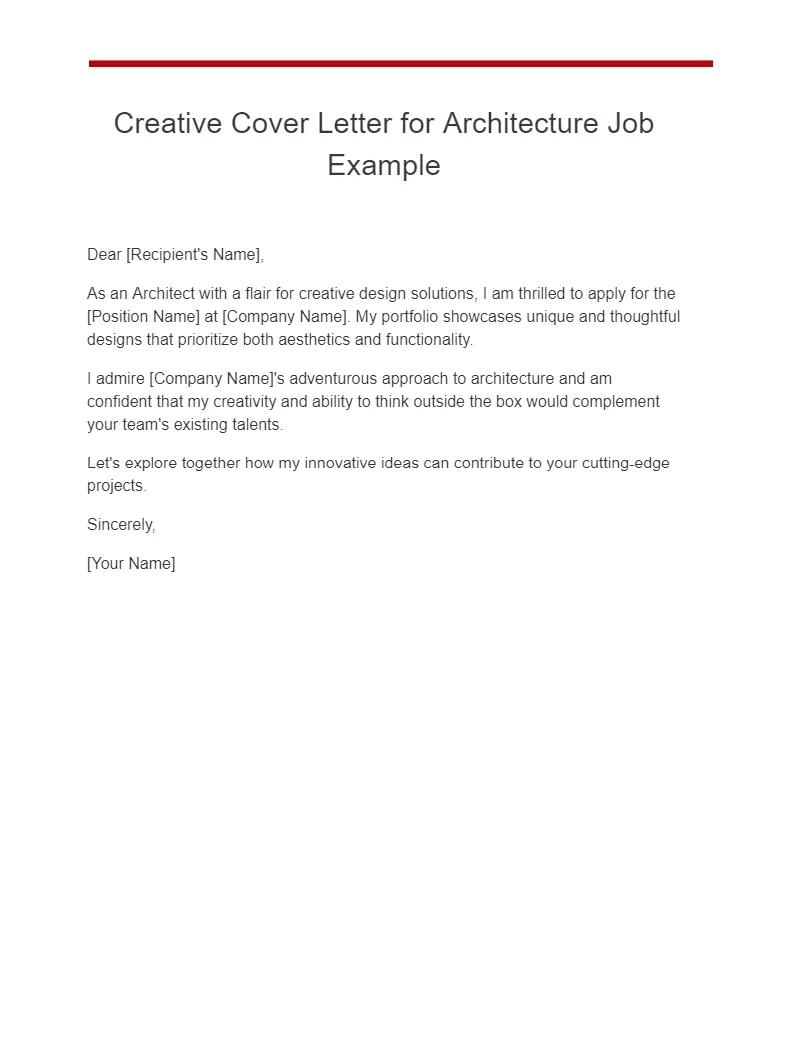
Show your enthusiasm for the role and the company. Explain why you are interested in working for this specific architecture firm. Mention any aspects of the firm’s work that resonate with you, and explain why you believe you would be a good fit for the team. Highlight any cultural alignment, and demonstrate that you’ve researched the company and understand its values and goals. This section is crucial because it indicates that you are genuinely interested in the company, not just any job. Be specific about why this particular role and this specific firm are appealing to you.
The Closing Paragraph
The closing paragraph should reiterate your interest in the position and thank the hiring manager for their time and consideration. Reiterate your enthusiasm and interest in an interview. Express your willingness to provide additional information or further discuss your qualifications. Restate your contact information and include a call to action, such as “I look forward to the opportunity to discuss my application further.” End with a professional closing such as “Sincerely” or “Respectfully” followed by your full name.
Proofreading and Editing Your Cover Letter
Before submitting your cover letter, proofread and edit it carefully. Errors can create a negative impression. Check for grammatical errors, spelling mistakes, and typos. Make sure the letter flows logically and the sentences are clear. Read the letter aloud to identify awkward phrasing or sentences that don’t flow. Consider asking a trusted friend, colleague, or career advisor to review your letter for feedback. Ensure the formatting is consistent. Ensure you have the correct contact information. Proofreading is essential to ensure your cover letter is polished and professional.
Using Keywords and Action Verbs
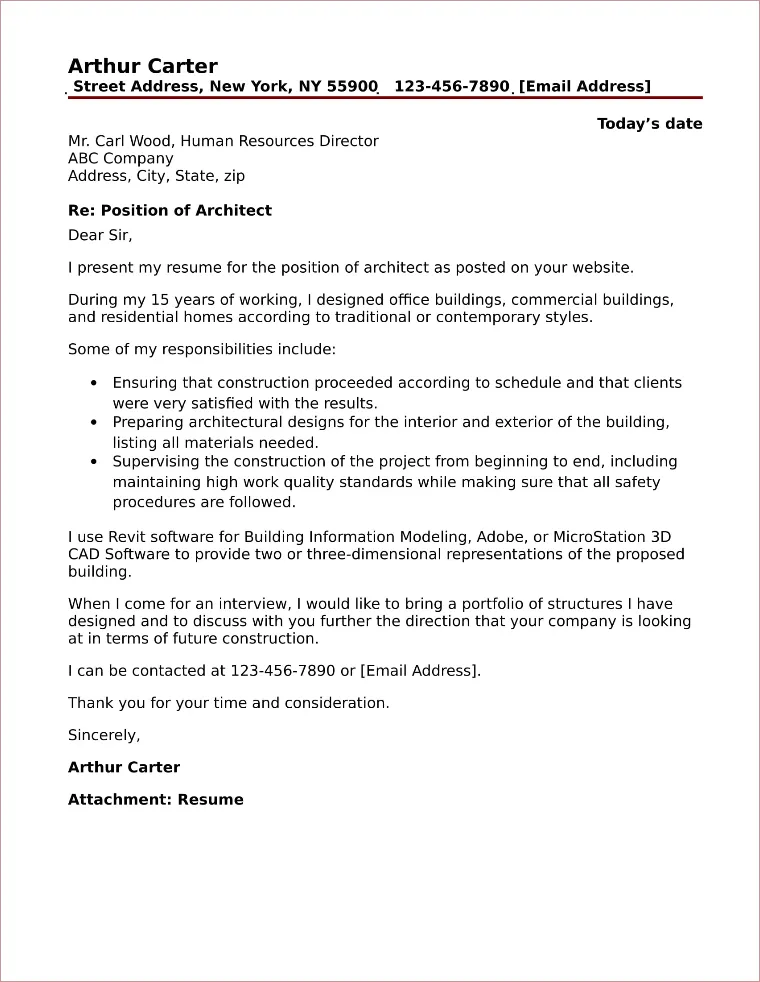
To make your cover letter stand out, strategically incorporate keywords and action verbs that are relevant to the job description. This helps you to align your skills and experience with the specific needs of the hiring company, making your application more targeted. Use action verbs such as ‘designed,’ ‘managed,’ ‘collaborated,’ ‘developed,’ and ‘implemented’ to describe your accomplishments and responsibilities. Incorporate keywords that are mentioned in the job description. Use these words naturally, but do not overstuff your letter. This will make your cover letter more likely to be noticed by Applicant Tracking Systems (ATS) and impress the hiring manager.
Researching the Architecture Firm
Demonstrate that you have done your homework by researching the architecture firm. Visit the company website, browse through their portfolio, and learn about their values and mission. Understand their past projects, their design philosophy, and their clients. Use this information in your cover letter to show your enthusiasm for the firm’s work. Mention specific projects or aspects of the firm that you admire, demonstrating that you are genuinely interested in their work. If possible, try to find information about the firm’s culture and values and relate them to your own values. This will enable you to tailor your application to the company. It shows you’re genuinely interested in their work.
Tailoring Your Letter to the Job Description
Every cover letter should be customized to fit the specific job description. Avoid using a generic cover letter. Read the job description carefully and identify the key requirements and qualifications. Highlight the skills and experiences most relevant to the position. Use the language used in the job description to showcase your qualifications. Align your cover letter with the job description to reflect your ability to meet the specific needs of the hiring company. Tailoring your cover letter is essential to show that you are a good fit for the role.
Common Mistakes to Avoid in Architect Cover Letters
Avoiding common mistakes is critical to creating an effective cover letter. Some common errors can immediately disqualify your application. Poorly written letters can indicate a lack of attention to detail. You should carefully review your letter and ensure you’ve avoided the most common mistakes.
Generic Cover Letters
Using a generic cover letter is a common mistake. A generic cover letter fails to demonstrate that you understand the specific requirements of the role or the values of the company. Generic cover letters don’t showcase your unique qualities or highlight why you are a good fit for the specific role and company. Create unique letters to show that you’ve done your research.
Typos and Grammatical Errors
Typos and grammatical errors can create a negative impression and show that you lack attention to detail. These types of errors suggest that you have not put enough effort into your application. Proofread your letter thoroughly and use spell-check and grammar-check tools. Consider asking a friend or colleague to review your letter before you submit it.
Lack of Specific Examples
Failing to provide specific examples is a common mistake. Avoid making vague claims about your skills and experience without providing evidence. Include examples of your achievements and contributions from previous projects. Describe the situations, your actions, and the results you achieved. Your examples should clearly show how you utilized your skills to achieve success in the past, which can indicate future success.
Overly Formal or Informal Tone
Maintaining a balanced and appropriate tone is essential. An overly formal tone can come off as stiff and impersonal, whereas an overly informal tone can undermine your professionalism. Maintain a professional tone. Use clear and concise language to get your point across. Make sure the tone matches the company culture.
Architect Cover Letter Examples and Templates
Leveraging examples and templates can be a helpful guide when writing your cover letter. Reviewing successful cover letters can give you a better understanding of what works. Adapt templates to fit your skills and experience.
Where to Find Sample Cover Letters
There are many resources available online where you can find examples of architect cover letters. Websites such as LinkedIn, Indeed, and various career advice platforms offer sample cover letters. Search for “architect cover letter examples” to find various templates. These resources will help you to see how other architects have presented themselves.
Adapting Templates to Your Needs
While templates can be helpful, remember that they should serve as a starting point, not a final product. Adapt the template to reflect your unique skills, experience, and the specific requirements of the job you are applying for. Make sure to replace the placeholder information with your own details. Use the template as a foundation and then tailor it to your needs.
The Importance of a Strong Call to Action
Including a strong call to action is crucial for driving the hiring manager to invite you for an interview. In your closing paragraph, clearly state your interest in the position and express your eagerness to discuss your qualifications further. Make it easy for the hiring manager to contact you by including your contact information, and also include the clear direction for next steps. A clear call to action signals your enthusiasm, as well as your ability to drive the process forward. By following these proven tips, you can create a compelling architect cover letter that secures you an interview and helps you land your dream job.
